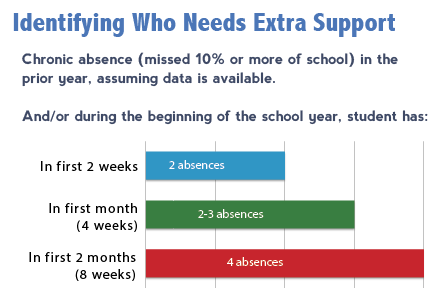Strategy 1: Monitor Chronic Absence Data
Monitoring chronic absence data is essential to ensuring educators are equipped to support their students. When school starts, data from the prior year can help alert educators to which students might need extra supports to start the year off right. In addition, it’s easy during the course of a busy school year to lose track of how absences are adding up for particular students. It’s difficult enough to notice when you have a class of 30 students. It’s even more difficult to notice how a day here or there adds up when you teach four or five classes a day. Regularly reviewing your class attendance data can help to identify which and how many students have so many absences they require some form of early intervention. As you review, be sure to look at excused as well as unexcused absences. Remember suspensions also count as time missed from classroom instruction.
Students who are likely to need additional support due to poor attendance are those who missed 10 percent or more of the previous school year as well as those who are headed off track in the current year. Examine the degree to which absenteeism is a challenge to help determine the intensity of interventions needed to improve attendance. Students missing 10-19 percent of school (9-17 days in a semester or 18-35 days over the course of a school year) are considered moderately chronically absent and generally can be helped with Tier 2 interventions. Tier 3 supports are often needed to help those who are severely chronically absent — missing more than 20 percent of the school year (18 or more days in a semester or 36 days over the course of a school year).

If you are working with a large number of chronically absent students and/or have several students with severe levels of absenteeism, consider sharing this information with a social worker, site administrator or community school coordinator (if applicable) to solicit their help and advice about how to address the situation.